Zeke Xie
CMPhysBench: A Benchmark for Evaluating Large Language Models in Condensed Matter Physics
Aug 25, 2025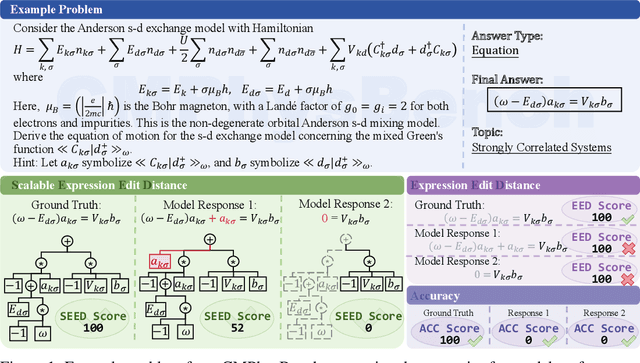
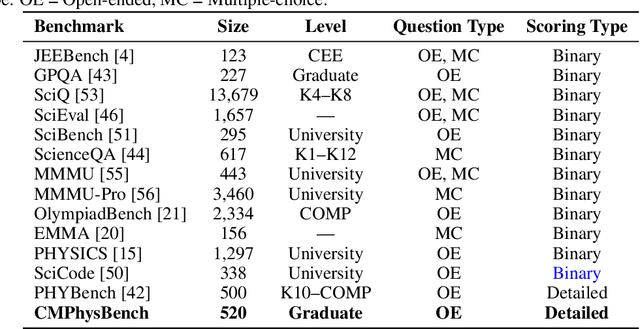


Abstract:We introduce CMPhysBench, designed to assess the proficiency of Large Language Models (LLMs) in Condensed Matter Physics, as a novel Benchmark. CMPhysBench is composed of more than 520 graduate-level meticulously curated questions covering both representative subfields and foundational theoretical frameworks of condensed matter physics, such as magnetism, superconductivity, strongly correlated systems, etc. To ensure a deep understanding of the problem-solving process,we focus exclusively on calculation problems, requiring LLMs to independently generate comprehensive solutions. Meanwhile, leveraging tree-based representations of expressions, we introduce the Scalable Expression Edit Distance (SEED) score, which provides fine-grained (non-binary) partial credit and yields a more accurate assessment of similarity between prediction and ground-truth. Our results show that even the best models, Grok-4, reach only 36 average SEED score and 28% accuracy on CMPhysBench, underscoring a significant capability gap, especially for this practical and frontier domain relative to traditional physics. The code anddataset are publicly available at https://github.com/CMPhysBench/CMPhysBench.
Understanding Data Influence with Differential Approximation
Aug 20, 2025Abstract:Data plays a pivotal role in the groundbreaking advancements in artificial intelligence. The quantitative analysis of data significantly contributes to model training, enhancing both the efficiency and quality of data utilization. However, existing data analysis tools often lag in accuracy. For instance, many of these tools even assume that the loss function of neural networks is convex. These limitations make it challenging to implement current methods effectively. In this paper, we introduce a new formulation to approximate a sample's influence by accumulating the differences in influence between consecutive learning steps, which we term Diff-In. Specifically, we formulate the sample-wise influence as the cumulative sum of its changes/differences across successive training iterations. By employing second-order approximations, we approximate these difference terms with high accuracy while eliminating the need for model convexity required by existing methods. Despite being a second-order method, Diff-In maintains computational complexity comparable to that of first-order methods and remains scalable. This efficiency is achieved by computing the product of the Hessian and gradient, which can be efficiently approximated using finite differences of first-order gradients. We assess the approximation accuracy of Diff-In both theoretically and empirically. Our theoretical analysis demonstrates that Diff-In achieves significantly lower approximation error compared to existing influence estimators. Extensive experiments further confirm its superior performance across multiple benchmark datasets in three data-centric tasks: data cleaning, data deletion, and coreset selection. Notably, our experiments on data pruning for large-scale vision-language pre-training show that Diff-In can scale to millions of data points and outperforms strong baselines.
Multiphysics Bench: Benchmarking and Investigating Scientific Machine Learning for Multiphysics PDEs
May 23, 2025Abstract:Solving partial differential equations (PDEs) with machine learning has recently attracted great attention, as PDEs are fundamental tools for modeling real-world systems that range from fundamental physical science to advanced engineering disciplines. Most real-world physical systems across various disciplines are actually involved in multiple coupled physical fields rather than a single field. However, previous machine learning studies mainly focused on solving single-field problems, but overlooked the importance and characteristics of multiphysics problems in real world. Multiphysics PDEs typically entail multiple strongly coupled variables, thereby introducing additional complexity and challenges, such as inter-field coupling. Both benchmarking and solving multiphysics problems with machine learning remain largely unexamined. To identify and address the emerging challenges in multiphysics problems, we mainly made three contributions in this work. First, we collect the first general multiphysics dataset, the Multiphysics Bench, that focuses on multiphysics PDE solving with machine learning. Multiphysics Bench is also the most comprehensive PDE dataset to date, featuring the broadest range of coupling types, the greatest diversity of PDE formulations, and the largest dataset scale. Second, we conduct the first systematic investigation on multiple representative learning-based PDE solvers, such as PINNs, FNO, DeepONet, and DiffusionPDE solvers, on multiphysics problems. Unfortunately, naively applying these existing solvers usually show very poor performance for solving multiphysics. Third, through extensive experiments and discussions, we report multiple insights and a bag of useful tricks for solving multiphysics with machine learning, motivating future directions in the study and simulation of complex, coupled physical systems.
DSADF: Thinking Fast and Slow for Decision Making
May 13, 2025



Abstract:Although Reinforcement Learning (RL) agents are effective in well-defined environments, they often struggle to generalize their learned policies to dynamic settings due to their reliance on trial-and-error interactions. Recent work has explored applying Large Language Models (LLMs) or Vision Language Models (VLMs) to boost the generalization of RL agents through policy optimization guidance or prior knowledge. However, these approaches often lack seamless coordination between the RL agent and the foundation model, leading to unreasonable decision-making in unfamiliar environments and efficiency bottlenecks. Making full use of the inferential capabilities of foundation models and the rapid response capabilities of RL agents and enhancing the interaction between the two to form a dual system is still a lingering scientific question. To address this problem, we draw inspiration from Kahneman's theory of fast thinking (System 1) and slow thinking (System 2), demonstrating that balancing intuition and deep reasoning can achieve nimble decision-making in a complex world. In this study, we propose a Dual-System Adaptive Decision Framework (DSADF), integrating two complementary modules: System 1, comprising an RL agent and a memory space for fast and intuitive decision making, and System 2, driven by a VLM for deep and analytical reasoning. DSADF facilitates efficient and adaptive decision-making by combining the strengths of both systems. The empirical study in the video game environment: Crafter and Housekeep demonstrates the effectiveness of our proposed method, showing significant improvements in decision abilities for both unseen and known tasks.
Mono2Stereo: A Benchmark and Empirical Study for Stereo Conversion
Mar 28, 2025Abstract:With the rapid proliferation of 3D devices and the shortage of 3D content, stereo conversion is attracting increasing attention. Recent works introduce pretrained Diffusion Models (DMs) into this task. However, due to the scarcity of large-scale training data and comprehensive benchmarks, the optimal methodologies for employing DMs in stereo conversion and the accurate evaluation of stereo effects remain largely unexplored. In this work, we introduce the Mono2Stereo dataset, providing high-quality training data and benchmark to support in-depth exploration of stereo conversion. With this dataset, we conduct an empirical study that yields two primary findings. 1) The differences between the left and right views are subtle, yet existing metrics consider overall pixels, failing to concentrate on regions critical to stereo effects. 2) Mainstream methods adopt either one-stage left-to-right generation or warp-and-inpaint pipeline, facing challenges of degraded stereo effect and image distortion respectively. Based on these findings, we introduce a new evaluation metric, Stereo Intersection-over-Union, which prioritizes disparity and achieves a high correlation with human judgments on stereo effect. Moreover, we propose a strong baseline model, harmonizing the stereo effect and image quality simultaneously, and notably surpassing current mainstream methods. Our code and data will be open-sourced to promote further research in stereo conversion. Our models are available at mono2stereo-bench.github.io.
MagicDistillation: Weak-to-Strong Video Distillation for Large-Scale Portrait Few-Step Synthesis
Mar 17, 2025



Abstract:Fine-tuning open-source large-scale VDMs for the portrait video synthesis task can result in significant improvements across multiple dimensions, such as visual quality and natural facial motion dynamics. Despite their advancements, how to achieve step distillation and reduce the substantial computational overhead of large-scale VDMs remains unexplored. To fill this gap, this paper proposes Weak-to-Strong Video Distillation (W2SVD) to mitigate both the issue of insufficient training memory and the problem of training collapse observed in vanilla DMD during the training process. Specifically, we first leverage LoRA to fine-tune the fake diffusion transformer (DiT) to address the out-of-memory issue. Then, we employ the W2S distribution matching to adjust the real DiT's parameter, subtly shifting it toward the fake DiT's parameter. This adjustment is achieved by utilizing the weak weight of the low-rank branch, effectively alleviate the conundrum where the video synthesized by the few-step generator deviates from the real data distribution, leading to inaccuracies in the KL divergence approximation. Additionally, we minimize the distance between the fake data distribution and the ground truth distribution to further enhance the visual quality of the synthesized videos. As experimentally demonstrated on HunyuanVideo, W2SVD surpasses the standard Euler, LCM, DMD and even the 28-step standard sampling in FID/FVD and VBench in 1/4-step video synthesis. The project page is in https://w2svd.github.io/W2SVD/.
CoRe^2: Collect, Reflect and Refine to Generate Better and Faster
Mar 12, 2025Abstract:Making text-to-image (T2I) generative model sample both fast and well represents a promising research direction. Previous studies have typically focused on either enhancing the visual quality of synthesized images at the expense of sampling efficiency or dramatically accelerating sampling without improving the base model's generative capacity. Moreover, nearly all inference methods have not been able to ensure stable performance simultaneously on both diffusion models (DMs) and visual autoregressive models (ARMs). In this paper, we introduce a novel plug-and-play inference paradigm, CoRe^2, which comprises three subprocesses: Collect, Reflect, and Refine. CoRe^2 first collects classifier-free guidance (CFG) trajectories, and then use collected data to train a weak model that reflects the easy-to-learn contents while reducing number of function evaluations during inference by half. Subsequently, CoRe^2 employs weak-to-strong guidance to refine the conditional output, thereby improving the model's capacity to generate high-frequency and realistic content, which is difficult for the base model to capture. To the best of our knowledge, CoRe^2 is the first to demonstrate both efficiency and effectiveness across a wide range of DMs, including SDXL, SD3.5, and FLUX, as well as ARMs like LlamaGen. It has exhibited significant performance improvements on HPD v2, Pick-of-Pic, Drawbench, GenEval, and T2I-Compbench. Furthermore, CoRe^2 can be seamlessly integrated with the state-of-the-art Z-Sampling, outperforming it by 0.3 and 0.16 on PickScore and AES, while achieving 5.64s time saving using SD3.5.Code is released at https://github.com/xie-lab-ml/CoRe/tree/main.
MagicInfinite: Generating Infinite Talking Videos with Your Words and Voice
Mar 07, 2025Abstract:We present MagicInfinite, a novel diffusion Transformer (DiT) framework that overcomes traditional portrait animation limitations, delivering high-fidelity results across diverse character types-realistic humans, full-body figures, and stylized anime characters. It supports varied facial poses, including back-facing views, and animates single or multiple characters with input masks for precise speaker designation in multi-character scenes. Our approach tackles key challenges with three innovations: (1) 3D full-attention mechanisms with a sliding window denoising strategy, enabling infinite video generation with temporal coherence and visual quality across diverse character styles; (2) a two-stage curriculum learning scheme, integrating audio for lip sync, text for expressive dynamics, and reference images for identity preservation, enabling flexible multi-modal control over long sequences; and (3) region-specific masks with adaptive loss functions to balance global textual control and local audio guidance, supporting speaker-specific animations. Efficiency is enhanced via our innovative unified step and cfg distillation techniques, achieving a 20x inference speed boost over the basemodel: generating a 10 second 540x540p video in 10 seconds or 720x720p in 30 seconds on 8 H100 GPUs, without quality loss. Evaluations on our new benchmark demonstrate MagicInfinite's superiority in audio-lip synchronization, identity preservation, and motion naturalness across diverse scenarios. It is publicly available at https://www.hedra.com/, with examples at https://magicinfinite.github.io/.
Learning from Ambiguous Data with Hard Labels
Jan 08, 2025
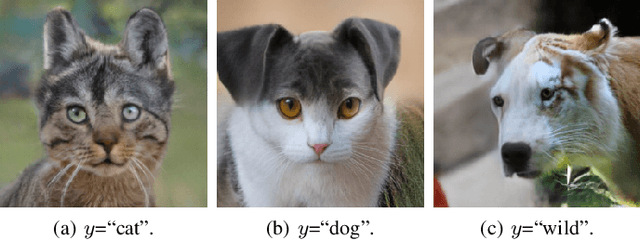
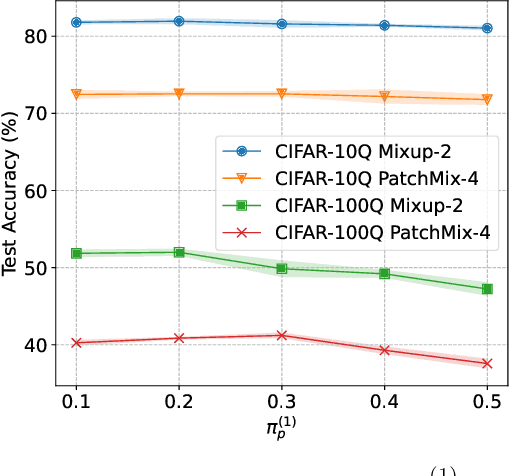
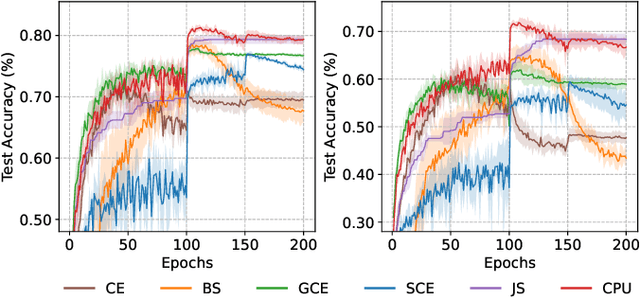
Abstract:Real-world data often contains intrinsic ambiguity that the common single-hard-label annotation paradigm ignores. Standard training using ambiguous data with these hard labels may produce overly confident models and thus leading to poor generalization. In this paper, we propose a novel framework called Quantized Label Learning (QLL) to alleviate this issue. First, we formulate QLL as learning from (very) ambiguous data with hard labels: ideally, each ambiguous instance should be associated with a ground-truth soft-label distribution describing its corresponding probabilistic weight in each class, however, this is usually not accessible; in practice, we can only observe a quantized label, i.e., a hard label sampled (quantized) from the corresponding ground-truth soft-label distribution, of each instance, which can be seen as a biased approximation of the ground-truth soft-label. Second, we propose a Class-wise Positive-Unlabeled (CPU) risk estimator that allows us to train accurate classifiers from only ambiguous data with quantized labels. Third, to simulate ambiguous datasets with quantized labels in the real world, we design a mixing-based ambiguous data generation procedure for empirical evaluation. Experiments demonstrate that our CPU method can significantly improve model generalization performance and outperform the baselines.
Zigzag Diffusion Sampling: Diffusion Models Can Self-Improve via Self-Reflection
Dec 17, 2024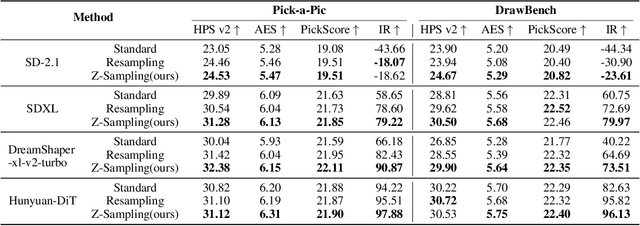
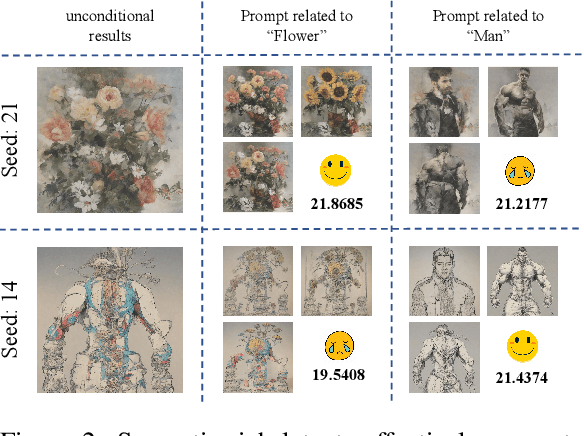

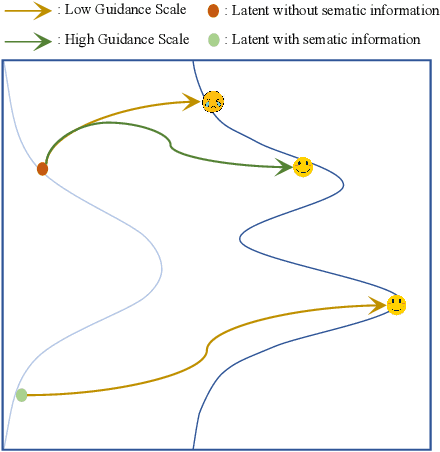
Abstract:Diffusion models, the most popular generative paradigm so far, can inject conditional information into the generation path to guide the latent towards desired directions. However, existing text-to-image diffusion models often fail to maintain high image quality and high prompt-image alignment for those challenging prompts. To mitigate this issue and enhance existing pretrained diffusion models, we mainly made three contributions in this paper. First, we propose diffusion self-reflection that alternately performs denoising and inversion and demonstrate that such diffusion self-reflection can leverage the guidance gap between denoising and inversion to capture prompt-related semantic information with theoretical and empirical evidence. Second, motivated by theoretical analysis, we derive Zigzag Diffusion Sampling (Z-Sampling), a novel self-reflection-based diffusion sampling method that leverages the guidance gap between denosing and inversion to accumulate semantic information step by step along the sampling path, leading to improved sampling results. Moreover, as a plug-and-play method, Z-Sampling can be generally applied to various diffusion models (e.g., accelerated ones and Transformer-based ones) with very limited coding and computational costs. Third, our extensive experiments demonstrate that Z-Sampling can generally and significantly enhance generation quality across various benchmark datasets, diffusion models, and performance evaluation metrics. For example, DreamShaper with Z-Sampling can self-improve with the HPSv2 winning rate up to 94% over the original results. Moreover, Z-Sampling can further enhance existing diffusion models combined with other orthogonal methods, including Diffusion-DPO.
 Add to Chrome
Add to Chrome Add to Firefox
Add to Firefox Add to Edge
Add to Edge